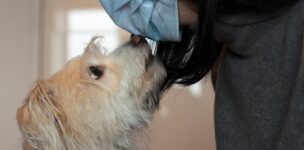When it comes to accurately diagnosing a disease, you might think you need expensive, high-tech machinery and equipment capable of looking deep beneath the skin at what’s going on in the body. But while these high-tech implements certainly are incredible, they aren’t the only instruments capable of detecting disease. In fact, you may even share a home with one of these powerful disease-detecting agents.
There are numerous of instances of unsuspecting pet owners learning they had a health problem from their pet. Examples include dogs licking, sniffing and even trying to chew spots on their owner’s skin – spots that were later diagnosed as malignant melanoma.
In fact, many species of animals – from the microscopic worm C elegans, to ants, mice and dogs – have all successfully demonstrated the ability to detect diseases in people and from biological samples during experiments.
The diseases detected are diverse – from cancer and urinary tract infections to COVID-19 and the gastrointestinal infection, Clostridium difficile.
Many of these diseases are potentially serious, especially in vulnerable and immunocompromised patients, so accurate and early detection is essential.
Here are just a few of the amazing animals that are able to detect disease in humans:
Dogs
Dogs are possibly the most well-known example of an animal that can detect a range of diseases – including Parkinson’s disease, bladder cancer and malaria. Epileptic seizures and low blood sugar in diabetic patients can also be detected by specially-trained medical alert dogs.
It seems that a dog’s impressive olfactory sense is key to their ability to detect specific odours, even at incredibly low concentrations. Indeed, the dog’s sense of smell is thought to be more than 10,000 times better than our own. They can even use their nostrils independently of each other when investigating new scents.
Biodetection and medical alert dogs are initially trained to associate specific odours with a positive reward – such as a tasty treat or toy. They then become primed to recognise odour changes or physical and behavioural changes in their handler that predict a seizure (or other health event).
Biodetection dogs will typically freeze when they recognise a scent, awaiting their reward. Medical alert dogs will often interact with their handler – perhaps pawing or nudging them to indicate that they need to take action for their safety.
Rats
Rats are also great at sniffing out specific smells.
The African giant pouched rat has been trained to detect the odour of land mine explosives in Mozambique. These rats are also proving to be valuable medical detection partners, playing an important role in the detection of tuberculosis in sputum samples recovered from suspected cases.

Rosa Jay/ Shutterstock
The rats are fast, taking only 20 minutes to review 100 patient samples. They use their sniffing skills to detect the distinctive chemical signature of tuberculosis in samples.
Their payment for a job well done is an avocado and banana treat. This makes these trained rats a valuable option where time and money might be limited in diagnostic and screening facilities. These rats have an incredible success rate – accurately detecting positive tuberculosis cases 81% of the time.
Bees
Even honeybees can detect the signs of certain diseases in samples – including lung cancer, tuberculosis and COVID-19.
Honeybees are extremely sensitive to low concentration odours, making them able to detect chemical changes in a similar way to dogs and rats.
Researchers have been able to train honeybees to respond to the presence of specific smells by rolling out their tongues for a sugar reward. With training, this response becomes consistent and highly sensitive for smells linked with disease states.
This ability makes honeybees useful for detecting disease in the same way as other animals. Their size could make them an even more efficient and low-cost option for rapid sample screening.
Superior senses
But how are animals able to identify the presence of specific diseases? It has to do with many animals’ ability to detect tiny changes in a person’s chemical scent profile.
Many species (including dogs, rats and bees) can detect very subtle changes in substances called volatile organic compounds (VOCs) that the body releases in very low levels, even when healthy. In fact, exhaled human breath contains approximately 3,500 different VOCs. The composition and concentration of VOCs the body releases changes based on a person’s health – and will be different if they’re fighting an infection or dealing with a health problem.
The disease-detecting abilities of animals aren’t just for human benefit, either. The worm C elegans can not only detect cancer in human samples, their superior olfactory senses mean they can also detect cancer in samples from dogs and cats.
The skills that different species have in accurately sniffing out disease might just make trained detection animals an effective, non-invasive, speedy and cost-effective way to screen for particular health conditions. It may even further enhance positive interactions between people and animals.
Notably, because of regulations, animals used for disease detection are currently only viewed as screening “tools” to be used alongside medical diagnostic techniques. But if regulatory frameworks permit, detection animals could one day become a key diagnostic component.
Indeed, detection dogs were faster (and cheaper) at screening samples for COVID-19 than routine PCR testing. By understanding the detection abilities of animals, we might just help improve laboratory diagnostic tests further by applying some of their amazing skills.
While exploiting the sniffing skills of animals might be useful for us, it’s important to remember that the health and welfare of the animals involved must be prioritised too. The ethics of working animals must always be taken into account alongside considerations of the cost, safety and efficiency of any widespread disease screening programmes that involves them.




